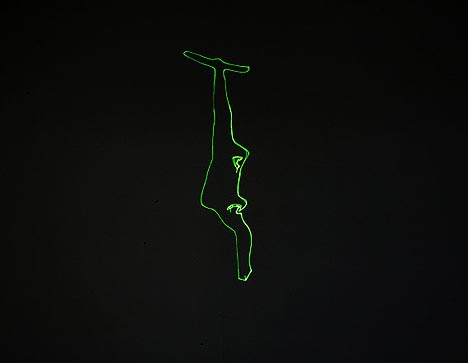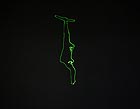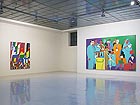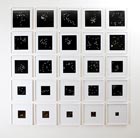
translated and summarized by: Liz Wollner-Grandville,
English summary November 17 - 23
LukasFeichtner Galerie: Stephan Reusse – monkey talk
The forgotten innovator
Stephan Reusse has not fallen into complete oblivion; actually his works sell well around the world, but his talents are not sufficiently recognised in Austria - especially regarding his accomplishments in the field of technical innovation.
The LukasFeichtner Gallery is currently showing Reusse's unusual technical art, created over the last three decades. Ranging from the “Pissflowers”, in which a photograph disappears and then reappears with the help of a chemical component found in urine, to “thermo photography”, and to his most recent work “monkey talk”. The basis of this work is a special laser projection system allowing the simple sketch of a green monkey to swing across the gallery wall.
However, Reusse’s works are incomprehensible without a detailed description and some background knowledge. But once immersed into Reusse’s universe of technology and cogitations, the onlooker will greatly enjoy the exhibit.
LukasFeichtner Galerie
1010 Vienna, Seilerstätte 19, until 06.12.08
www.feichtnergallery.com
Staatliche Kunsthalle Karlsruhe: Édouard Vuillard
Predicate delicate
In 1888, Paul Sérusier, Pierre Bonnard, Maurice Denis, and Édouard Vuillard - at that time all in their twenties - formed the artist group “Nabis” (Hebrew=prophet). The name was meant to encapsulate the group’s collective, post-Nazarene identity. Contrary to the Impressionists, named after their style of art, the "Nabis" identified themselves through the role they played in the world of art.
Maurice Denis was the one who coherently described the goal of the “Nabis” and who made the group famous. He pointed it that it was important to "remember that a painting, no matter if it depicted a war horse, a nude or any anecdote, was nothing but a plain surface, filled with colours, spread according to a certain order.”
“Nabis” acquired a taste for lithography and flat screen-printing. The exhibit at the Karlsruher Kunsthalle focuses on Vuillard’s works, however, without neglecting those of his colleagues . If the word 'delicate' still has some value today, then definitely here: this art is delicate.
Staatliche Kunsthalle Karlsruhe
76133 Karlsruhe, Hans-Thoma-Strasse 2-6, until 25.01.09
www.kunsthalle-karlsruhe.de
Georg Kargl Fine Arts: Lisa Ruyter – Atoms for Peace
Transfer of perception
For more than ten years the American artist Lisa Ruyter has consequently dealt with the primacy of painting and its inevitable relationship to photographic models and likenesses. These snapshots are the basis for the pictorial remembrance of moments transferred to large-scale tableaux by the artist, which in hindsight are always fragments of reality. Ruyter's characteristic contouring of individual image areas, each covered with colours reflecting a special colour scale typical for her, produce supernatural scenes of a world, which is continuously under media surveillance.
Fashion shows, parties or cemeteries - the themes are always linked to socio-political events, in which all private or public aspects merge.
For the current exhibit at Georg Kargl Fine Arts, Ruyter used photos, shot at a conference held at the Atomic Energy Organisation in Vienna. The commonly used bright neon colours are less accentuated in this artistic documentation of the scientific and political acts, thereby underlining the alleged seriousness of the event. But Ruyter’s paintings are proof of her masterful employment of colour, in which the content of the paintings serve as a transparency for a surrealistic transfer of reality.
The proportionality of the works is confirmed by the way they are distributed within the gallery and offer a conclusive scenario in connection to the subject of the exhibit. Ruyter's work not only enriches the gallery, but also the entire Viennese art scene.
Georg Kargl Fine Arts
1040 Vienna, Schleifmühlgasse 5, until 11.01.09
www.georgkargl.com
Galerie Lindner: Günther and Loredana Selichar – 844 Photograms
Worth its weight
The photograms created by Günther and Loredana Selichar show nothing but small white dots on a black background. Seemingly placed at random, their minimalistic playfulness develops its own charm. Through the outstanding text written for the exhibit by Ruth Horak, one learns that every single dot originated from one-gram weights, all of which were individually placed onto the photo paper. It becomes clear that the works are as accurate as they could ever be: the weight of each photo paper equals the number of grams that were placed onto it. The 97 photograms actually weigh 97 grams. Photo art is rarely as precise as this.
The small gallery arranged this exhibit with passion for detail. If you have the time to see sophisticated art presented slightly away from the usual gallery districts, you will greatly enjoy this presentation.
Galerie Lindner
1060 Vienna, Schmalzhofgasse 13/3, until 28. 11. 08
www.galerie-lindner.at
Mehr Texte von translated and summarized by: Liz Wollner-Grandville


 Teilen
Teilen




